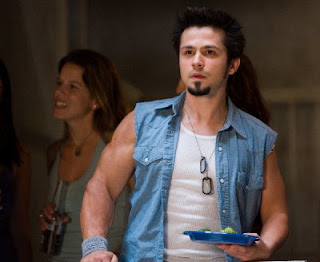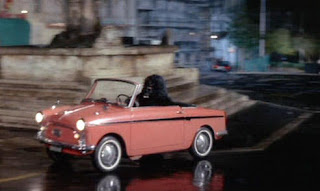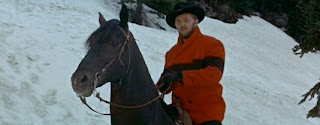So, when I finally got around to watching M. Night Shyamalan's The Lady in the Water (2006), I found that I actually liked it and thought that it was a pretty good movie. Which is not to say that I think it was unfairly panned by critics or that it was "underrated". Actually, even though I like the movie, it does three things that are impossible not to criticize and, while I was able to more or less ignore these things, if you can't ignore them or don't want to ignore them, my guess would be that the movie would drive you batty.
He names the two species of fairytale creatures "Narfs" and "Scrunts". These words look silly enough on paper, but it is even sillier to hear actors say these words while keeping a completely serious look on their face. The silliness turns to something genuinely annoying, because we keep hearing "narfs" and "scrunts" over and over again. And while "narf" is just sort of ridiculous, someone involved in making the movie should have told M. Night not to give a fantasy creature a name that sounds like the combination of "scrotum" and "cunt". I expect this is fundamental to what killed the movie with the general audience.
In a rather petty, adolescent move, he makes the "jerk" character a movie critic (named Farber), I guess to get back at critics who didn't like Signs and The Village (or something). M. Night has always been bigger with the people than with the critics (although his first two films were fairly well reviewed for genre movies), but one would have hoped that he'd be able to rise above this kind of mean-spiritedness if only because he's been so successful despite what critics have had to say.
M. Night makes it even worse by giving his hero a speech that goes something like "How dare that critic interpret a story! How dare he assume that his interpretation is the only correct one!" This is so absurd because all of M. Night's movies are allegorical: they are crying out to be interpreted and at their best (The Sixth Sense, Unbreakable), like any good allegory, they support multiple readings!
Maybe he could have gotten away with it if he had stopped with the first two annoying things, but I think this one really pushed him over the edge as far as movie critics were concerned. It's one thing to suggest that all critics are know-nothing parasites, it is another thing, though, to cast yourself as an author of a book of such world-changing importance that magical creatures go to war over your very survival. It's not even cocky or conceited or arrogant: it's just absurd! I mean: though M. Night has appeared in his other movies, it's always in small (though not insignificant) roles. Here, while he's not the protagonist, he's at the center of the film and you can't help putting the pieces together. That is: he casts himself in the role because he believes (on some level) that he is the author whose work will have world changing importance. How's that for setting yourself up as a target of ridicule and scorn?
Actually, it's the size and obvious deliberateness of these "Annoying Things" that make it possible for me to ignore them (more or less) and like the movie anyway. In a perverse way, I might even like the movie more because of them: not because they aren't really annoying, but because they are such obviously bad ideas that they're almost too easy to beat up on. It's like he's asking for the abuse.
So - what exactly is there to like in a non-perverse way?
Well, have you read any of James P. Blaylock's novels? He's one of my favorite fantasy authors (I recommend The Last Coin and The Paper Grail). I tend to describe his books as being like Stephen King's with the horror/scare-factor dialed way down, although they're a lot more modest. They're generally about a contemporary American everyman bumping up against the fantastic in the middle of everyday contemporary American life. Despite some of the megalomania that manifests itself in Annoyances 2 and 3 (not to mention the huge budget), The Lady in the Water is similarly modest movie. "The Everyday" is never overwhelmed by "The Fantastic": rather, "The Fantastic" is always creeping around the edges. And, as in Blaylock's books, the characters are all refreshingly low-key.
(Alas, the climax of the movie features the kind of half-assed mumbo jumbo hand-waving as most recent Stephen King novels.)
From a film geek perspective, I like all of M. Night's long takes and his willingness to give his actors room (both time and space) to develop their performances. And I also like the way he works in self-imposed limitations, like never taking us outside of the apartment complex. It's a bit of a stunt, but (somewhat paradoxically) a low key stunt that doesn't call attention to itself. It's more noticeably in retrospect. I like seeing someone making a big budget movie for popular audiences that doesn't pander and doesn't ape all the standard conventions of big budget filmmaking.
That said, Adam at Film at 11 is probably right to put the Strained Seriousness label on M. Night.



